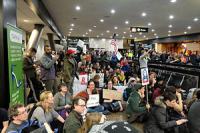-
Appellate court issues encouraging border search opinion
The U.S. Court of Appeals for the Fifth Circuit in U.S. v. Molina-Isidoro recently issued an encouraging opinion related to the digital privacy of travelers crossing the U.S. border. The Electronic Frontier Foundation (EFF) filed an amicus brief last year in the case, arguing that the Supreme Court’s decision in Riley v. California (2014) supports the conclusion that border agents need a probable cause warrant before searching electronic devices because of the unprecedented and significant privacy interests travelers have in their digital data. In Riley, the Supreme Court followed similar reasoning and held that police must obtain a warrant to search the cell phone of an arrestee.
-
-
Federal judge rules White House can continue building border wall
U.S. District Judge Gonzalo Curiel, who the president once asserted could not be fair to Trump because of Curiel’s Mexican heritage, has ruled in favor of the White House in a lawsuit over construction of a border wall.
-
-
Supreme Court declines to enter DACA fray
The Supreme Court announced today (Monday) that it will not, at least for now, enter the legal fight over the Trump administration’s cancellation of the Deferred Action for Childhood Arrivals (DACA) program. The court’s decision to allow the U.S. Court of Appeals for the 9th Circuit to resolve the legal challenges to the administration’s plan means the administration cannot proceed with its plan to end the DACA program until the end of a few more months of appeals, that is, past the 5 March deadline the administration had set to for the 800,000 “Dreamers” who arrived in the country illegally as children.
-
-
Trump's travel ban “unconstitutionally tainted with animus toward Islam”: Court
The 4th U.S. Circuit Court of Appeals in Richmond, Virginia, on Thursday described the latest version of Donald Trump’s travel ban as “unconstitutionally tainted with animus toward Islam.” In a 9-4 vote, the federal appeals court said the ban on travelers from six predominantly Muslim countries is unconstitutional because it discriminates against people based on their religion. In its ruling, the 4th Circuit said the presidential proclamation imposing the ban has a “much broader deleterious effect” than banning certain foreign nationals. The ban, the court said, “denies the possibility of a complete, intact family to tens of thousands of Americans.” “On a fundamental level, the Proclamation second-guesses our nation’s dedication to religious freedom and tolerance,” Chief Justice Roger Gregory wrote for the court in the majority opinion.
-
-
ISIS fighters on migrant boats a “real risk”: Italy
Mediterranean migrant boats headed for Europe could be carrying fugitive ISIS fighters, Italian Foreign Minister Angelino Alfano has asserted at a Rome conference, where he has been hosting African, EU, and UN officials. “It is in our interests, to defeat the business model of traffickers whose profits are used to finance organized crime and, we have the evidence for this, terrorism,” Alfano said. Analysts note that as a result of increased operations by the EU’s border agency, Frontex, in the central Mediterranean, migration pressure has shifted west to Algeria and Morocco as migrants, still intent on reaching Europe, head for Spain, some via its African outposts of Ceuta and Melilla.
-
-
Debunking 3 myths behind “chain migration” and “low-skilled” immigrants
President Donald Trump has embraced the rhetoric of “chain migration” to spread the message that the United States is legally letting in too many of the wrong kind of immigrant. That term, however, distorts the facts. As a scholar on U.S. immigration law and policy, I’d like to correct and contextualize the numbers on the now maligned “family-based immigration,” and uncover the biases that underlie the preference for the “highly-skilled” immigrant. Family immigration is subject to significant limitations and it exists because American values include ideals such as family unification.
-
-
Smuggling of people from Africa to Europe conducted by “independent traders,” not Mafia-like monopoly
First study to model the organization behind trade in illegal border crossings shows no “Mafia-like” monopoly of routes from Africa into Europe via Mediterranean. Instead, myriad independent smugglers compete in open markets that have emerged at every stage of the journey.
-
-
Texas smugglers say Trump's border wall wouldn't stop immigrants, drugs from pouring across the border

If the Trump administration follows through on the president’s promises to build a border wall, would it actually stop undocumented immigrants and illegal drugs? Two former smugglers explain how they’d work around it.
-
-
New algorithm to help resettle refugees, improve their integration
In recent years, a record number of people have been displaced as a result of war, persecution, and other human rights violations, surpassing the numbers seen after the Second World War. In 2016 alone, about 65.6 million people were forced to flee their homes. Researchers have developed a new machine learning algorithm which could help governments and resettlement agencies find the best places for refugees to relocate, depending on their particular skills and backgrounds.
-
-
Administration waives more than 30 environmental laws for New Mexico section of border wall

The Trump administration on Monday waived more than thirty environmental laws to speed construction of twenty miles of border wall in eastern New Mexico, the third time the waiver has been used by the Trump administration. The waiver is meant to allow construction of the New Mexico border wall section without having to comply with laws that protect clean air, clean water, public lands, or endangered wildlife.
-
-
Climate change will displace millions in coming decades. Nations should prepare now to help them
By the middle of this century, experts estimate that climate change is likely to displace between 150 and 300 million people. If this group formed a country, it would be the fourth-largest in the world, with a population nearly as large as that of the United States. Yet neither individual countries nor the global community are completely prepared to support a whole new class of “climate migrants.” The scale of this challenge is unlike anything humanity has ever faced. By midcentury, climate change is likely to uproot far more people than the Second World War, which displaced some 60 million across Europe, or the Partition of India, which affected approximately 15 million. The migration crisis that has gripped Europe since 2015 has involved something over one million refugees and migrants. It is daunting to envision much larger flows of people, but that is why the global community should start doing so now.
-
-
Climate change will displace millions of people. Where will they go?

The 1951 Refugee Convention defines a protected refugee as someone who leaves his or her home country due to racial, religious, or social persecution, or reasonable fear of such persecution. These refugees have the right to seek asylum and protection from participating members of the United Nations (though these countries are not obligated to take them in). However, people displaced by climate change do not fit this definition. At the international level, there is no legal mechanism in place to protect climate migrants’ rights and to ensure assistance from other countries. For climate relocation to work, governments need to care and commit to international responsibility and burden-sharing. However, in the current global political context of fear of terrorism, an increased refugee influx into Europe, and an overall rise of xenophobia, countries are more likely to opt for stricter policies on cross-border migration.
-
-
Trump’s “Muslim ban” produced rare shift in public opinion: Study

President Donald Trump signed Executive Order 13769 on 27 January 2017, effectively barring individuals from seven predominately Muslim countries from entering the United States for ninety days. Within a day of his decree, thousands of protesters flooded airports around the country in opposition to what was quickly deemed a “Muslim ban,” and by 6 March, the order had been formally revoked. Researchers say that the profound response to the ban represents “one instance in which the priming of American identity shifted citizens’ opinions toward more inclusive, rather than restrictive, immigration-related policy stances.” Overall, the findings suggest that American identity can be “primed” to produce shifts in public opinion. It also demonstrates that public opinion may be more malleable than previously thought.
-
-
DHS’s airport biometric exit program faces budgetary, legal, technical, and privacy questions
DHS has installed experimental face-recognition system in nine U.S. airports. If DHS’s current plans are executed, every traveler flying overseas, American and foreign national alike, will soon be subject to a face recognition scan as part of this “biometric exit” program. A new report notes that neither Congress nor DHS has ever justified the need for the program. Congress never provided a rationale for it. Congress never provided a rationale for it while DHS has repeatedly questioned “the additional value biometric air exit would provide.” The biometric exit program also stands on shaky legal ground, and to make matters worse, the face scanning technology used by DHS may make frequent mistakes. “The privacy concerns implicated by biometric exit are at least as troubling as the system’s legal and technical problems,” the report notes.
-
-
Hotter temperatures will accelerate asylum-seekers migration to Europe
New research predicts that migrants applying for asylum in the European Union will nearly triple over the average of the last fifteen years by 2100 if carbon emissions continue on their current path. The study suggests that cutting emissions could partially stem the tide, but even under an optimistic scenario, Europe could see asylum applications rise by at least a quarter.
-
- All
- Regional
- Water
- Biometrics
- Borders/Immig
- Business
- Cybersecurity
- Detection
- Disasters
- Government
- Infrastructure
- International
- Public health
- Public Safety
- Communication interoperabillity
- Emergency services
- Emergency medical services
- Fire
- First response
- IEDs
- Law Enforcement
- Law Enforcement Technology
- Military technology
- Nonlethal weapons
- Nuclear weapons
- Personal protection equipment
- Police
- Notification /alert systems
- Situational awareness
- Weapons systems
- Sci-Tech
- Sector Reports
- Surveillance
- Transportation
Advertising & Marketing: advertise@newswirepubs.com
Editorial: editor@newswirepubs.com
General: info@newswirepubs.com
2010-2011 © News Wire Publications, LLC News Wire Publications, LLC
220 Old Country Road | Suite 200 | Mineola | New York | 11501
Permissions and Policies
Editorial: editor@newswirepubs.com
General: info@newswirepubs.com
2010-2011 © News Wire Publications, LLC News Wire Publications, LLC
220 Old Country Road | Suite 200 | Mineola | New York | 11501
Permissions and Policies
